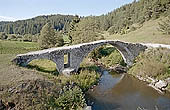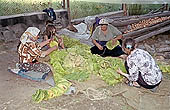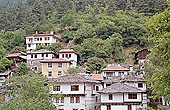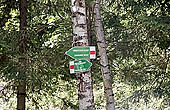The beautiful Rhodopi mountains is a karst area with spectacular gorges, large caves conifer woods alpine meadows. In the heart of the fairy
Rhodopi landscape the dam of Dospat, close to the town with the same name,
is one of the biggest dams in Bulgaria. Located 1200 masl it is the highest in
Bulgaria, the nature around is incredible and old pine forests surround the lake. The dam is rich in fish and we had a lovely time eating fish in
a restaurant overlooking the dam.
Rhodopi mountains Bulgaria |

|
Leaving Dospat the road conditions are so bad that the modern world seems
remote.
This is one of the less developed rural areas of the country, home to Bulgaria's most isolated and ethnically diverse communities.
Villages distinguished by minarets and women attired in smocks and wimples, it is here
that most of the Muslim population lives:
the Pomaks, in many villages of the region they form the majority of the population.
Pomaks are descendants of ethnic Bulgarians who accepted the Islamic faith during Ottoman rule, between the xvi and xviii centuries. They remained isolated for centuries and did not become ethnically mixed with their coreligionist Turks during the
occupation. They largely retained their Slavic physical features, saving the old
Bulgarian language and some old customs which took place before xvii century.
Life in the villages continues much as it did centuries ago, both Muslims and Christians live in stone houses cultivating tobacco, which dries on racks in every
garden.
The Rhodopi mountains gave life to the Orpheus and Evredika myth . The crystalline rocks that can be found in the mountains are called by local people
'the tears of Evredika', and the earth itself is her body.
This is the place where the Orphic cult originated. Orpheus, musician, magician and healer, was a native Thracian born in the Rhodopi
. After having lost his Evredika, Orpheus roamed inconsolable the mountains spurning female company until the women of Thrace (Bacchantes or Maenads followers of Dionysus) tore him apart and flung his dismembered body into the river. His head floated along the river Mesta to Lesbos where it began to prophesy and became famous as an Oracle. Archaeologists believe that beneath the
myth there may have lived a real Orpheus, a priest of Dionysus who introduced a new spiritual movement linked to the sun god Apollo and claim that a tomb recently found in the Eastern Rhodopi could possibly be the grave of Orpheus.

|
Rhodopi mountains Bulgaria
|
Village of Shiroka Luka
In the narrow valley of the Shirokolashka river, at the foot of the Western
Rhodopi Mountains, at 1060 masl Shiroka Luka is a museum village well known for its original
Rhodopi architectural style, musical traditions and history.
The village, declared an architectural reserve, has preserved its
original appearance, its numerous old houses of the Bulgarian National
Revival, winding narrow-pebbled streets and bridges arching the
river.
The village is famous for its authentic folklore and it is also the birthplace of several popular kaba
bagpipe players.
The Holy Virgin church (xix century) has frescos painted by
the brothers Zachary and Dimitur Zograf.
Shiroka Luka Bulgaria |

|
The Trigrad Gorge and The Devil’s Throat
Spreading for about 3 km, this magnificent gorge is situated in the valley of Trigradska
river. The 250 meters high, sheer rocks rise at the two sides of the river and form a narrow rocky bed. The average altitude of the gorge is 1450
m, the lowest part is at Bukov most (Beech-tree bridge) – 946.5 masl, and the highest point is the peak of Kulata (1543masl).
Following the gorge one arrives at the Devil's Throat Cave, near Trigrad village, the most famous of the more than 150 caves of the region.
Following the 150m artificial tunnel one can reach the impressive hall, so
high that could accommodate the Alexander Nevski Cathedral in Sofia. From the hall
a staircase leads to the natural entrance of the cave where the visitor can see one of the highest underground waterfalls in Europe (42m).
A legend says it was here that Orpheus went under earth to the kingdom of Hades to save his beloved
Euridika.
According to a Thracian legend it was here that the chieftains threw themselves into to become immortal. People believed with veneration that it was the entrance to the other world, the way to immortality. To propitiate the evil they offered as a sacrifice the most beautiful girls.

|
Devil's Throat Cave Bulgaria
|
|
|
|



